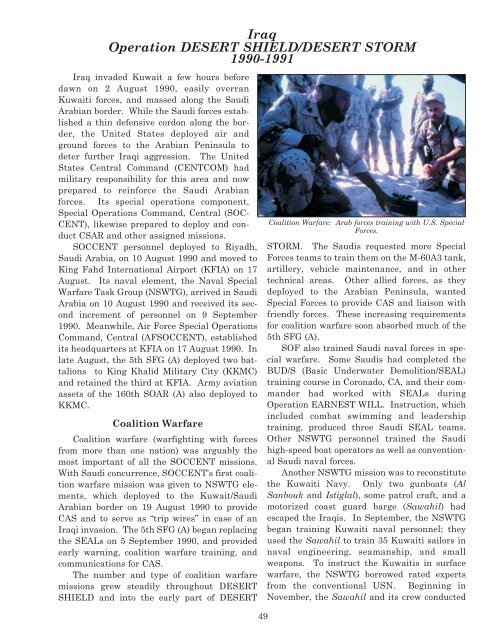HQ$History - United States Special Operations Command
HQ$History - United States Special Operations Command
HQ$History - United States Special Operations Command
Create successful ePaper yourself
Turn your PDF publications into a flip-book with our unique Google optimized e-Paper software.
Iraq<br />
Operation DESERT SHIELD/DESERT STORM<br />
1990-1991<br />
Iraq invaded Kuwait a few hours before<br />
dawn on 2 August 1990, easily overran<br />
Kuwaiti forces, and massed along the Saudi<br />
Arabian border. While the Saudi forces established<br />
a thin defensive cordon along the border,<br />
the <strong>United</strong> <strong>States</strong> deployed air and<br />
ground forces to the Arabian Peninsula to<br />
deter further Iraqi aggression. The <strong>United</strong><br />
<strong>States</strong> Central <strong>Command</strong> (CENTCOM) had<br />
military responsibility for this area and now<br />
prepared to reinforce the Saudi Arabian<br />
forces. Its special operations component,<br />
<strong>Special</strong> <strong>Operations</strong> <strong>Command</strong>, Central (SOC-<br />
CENT), likewise prepared to deploy and conduct<br />
CSAR and other assigned missions.<br />
SOCCENT personnel deployed to Riyadh,<br />
Saudi Arabia, on 10 August 1990 and moved to<br />
King Fahd International Airport (KFIA) on 17<br />
August. Its naval element, the Naval <strong>Special</strong><br />
Warfare Task Group (NSWTG), arrived in Saudi<br />
Arabia on 10 August 1990 and received its second<br />
increment of personnel on 9 September<br />
1990. Meanwhile, Air Force <strong>Special</strong> <strong>Operations</strong><br />
<strong>Command</strong>, Central (AFSOCCENT), established<br />
its headquarters at KFIA on 17 August 1990. In<br />
late August, the 5th SFG (A) deployed two battalions<br />
to King Khalid Military City (KKMC)<br />
and retained the third at KFIA. Army aviation<br />
assets of the 160th SOAR (A) also deployed to<br />
KKMC.<br />
Coalition Warfare<br />
Coalition warfare (warfighting with forces<br />
from more than one nation) was arguably the<br />
most important of all the SOCCENT missions.<br />
With Saudi concurrence, SOCCENT’s first coalition<br />
warfare mission was given to NSWTG elements,<br />
which deployed to the Kuwait/Saudi<br />
Arabian border on 19 August 1990 to provide<br />
CAS and to serve as “trip wires” in case of an<br />
Iraqi invasion. The 5th SFG (A) began replacing<br />
the SEALs on 5 September 1990, and provided<br />
early warning, coalition warfare training, and<br />
communications for CAS.<br />
The number and type of coalition warfare<br />
missions grew steadily throughout DESERT<br />
SHIELD and into the early part of DESERT<br />
49<br />
Coalition Warfare: Arab forces training with U.S. <strong>Special</strong><br />
Forces.<br />
STORM. The Saudis requested more <strong>Special</strong><br />
Forces teams to train them on the M-60A3 tank,<br />
artillery, vehicle maintenance, and in other<br />
technical areas. Other allied forces, as they<br />
deployed to the Arabian Peninsula, wanted<br />
<strong>Special</strong> Forces to provide CAS and liaison with<br />
friendly forces. These increasing requirements<br />
for coalition warfare soon absorbed much of the<br />
5th SFG (A).<br />
SOF also trained Saudi naval forces in special<br />
warfare. Some Saudis had completed the<br />
BUD/S (Basic Underwater Demolition/SEAL)<br />
training course in Coronado, CA, and their commander<br />
had worked with SEALs during<br />
Operation EARNEST WILL. Instruction, which<br />
included combat swimming and leadership<br />
training, produced three Saudi SEAL teams.<br />
Other NSWTG personnel trained the Saudi<br />
high-speed boat operators as well as conventional<br />
Saudi naval forces.<br />
Another NSWTG mission was to reconstitute<br />
the Kuwaiti Navy. Only two gunboats (Al<br />
Sanbouk and Istiglal), some patrol craft, and a<br />
motorized coast guard barge (Sawahil) had<br />
escaped the Iraqis. In September, the NSWTG<br />
began training Kuwaiti naval personnel; they<br />
used the Sawahil to train 35 Kuwaiti sailors in<br />
naval engineering, seamanship, and small<br />
weapons. To instruct the Kuwaitis in surface<br />
warfare, the NSWTG borrowed rated experts<br />
from the conventional USN. Beginning in<br />
November, the Sawahil and its crew conducted

















